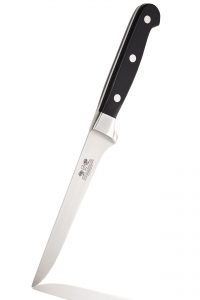Introduction
Quick Navigation
Whenever you get yourself a kitchen knife set, you notice a variety of knife types. The issue is that you may not know which knife to use when it comes to cutting meat, fruit, or vegetables. You may choose the wrong knife to cut a tough cut of meat, and then you end up feeling very frustrated that you fail in cutting the meat. You may barely cut the flesh and find that most of the meat still has an attachment to the bone. The reason you could not cut the meat correctly was that you used the wrong knife. It would be best if you used a boning knife to cut tough foods delicately.
What Is A Boning Knife?
Most kitchen knife sets include a boning knife, and if you know its appearance, you will find it quickly in the set. A boning knife is narrow and long, which features a blade measuring from five to seven inches long. The blade is partially flexible, and the top of the edge slightly curves up. Some blades, however, are rigid, which depends on the boning knife. You do not need to worry about your hand coming in contact with the blade as the bolster, or small guard prevents that from happening.
A boning knife is the most known for delicately cutting meat away from the bones. However, professional chefs and other cooks use the knife for cutting various foods that do not contain bones. Therefore, you don’t only need to use a boning knife to cut tough meats.
What Foods Other Than Meat Can You Cut With A Boning Knife?
Many chefs and cooks use boning knives for hard-to-cut vegetables such as squash and fruits such as pineapples. They can use them for baked goods, which sounds strange since cakes and other pastries are easy to cut. However, it boils down to carving fruits and baked goods in a unique way.
Even though you do not need to separate the flesh from the bones, you can use boning knives to carve vegetables, fruits, and baked goods uniquely. Many chefs use those knives to peel the skin off of fruits and vegetables quickly and cleanly. Bakers use the knife to carve cakes and pastries, and even cookies in different shapes. They use the boning knife to sharpen the edges of square-shaped pastries and cakes and to even layers for cakes that feature layers. There are so many different uses for boning knives.
What Is The Main Uses For Boning Knives?
Even though you now know that you can cut various foods with boning knives, the primary use is to cut and prepare meat. Whether it is beef, pork, lamb, or poultry. Meat has plenty of fat and cartilage, which you want to remove during preparation. You may wish your meat to have some fat as you prepare it. However, the blade’s flexibility allows you to cut the meat away from tight areas. In addition to that, the curved tip allows you to cut the meat from the cartilage once you get to the joints, which are pretty helpful when it comes to cutting up poultry.
For instance, if you want to carve that turkey for Thanksgiving, Christmas, or any random occasion, you can quickly prepare that bird any way you choose. The boning knife allows you to cut away the breast, dark meat, and other meat away from the carcass without shaving off the fragments from the bones. Therefore, the boning knife allows you to prepare the turkey cleanly and neatly. You can also look at how to use a boning knife to cut chicken as you can break the chicken meat down into various cuts. You can do the same thing with beef, lamb, and pork. The best thing is that using a boning knife is so easy.
How Do You Use A Boning Knife?
Using a boning knife is simple. The first and foremost thing you need to do when using a boning knife is to be mindful of your grip, and you have to hold it in a way that is the most comfortable to you. For example, you are cutting beef away from the bone. You will want to wrap your fingers around the handle tightly and comfortably. You can also use the pinch grip, which means you pinch the blade between your forefinger and thumb while your other fingers comfortably wrap around the handle of the boning knife.
The pinch grip allows you to provide a firm grip, so the knife does not slip around as you use it. The hold will enable you to have excellent control over the blade so you can make the best use of it in a safe way. You also will want to care for your boning knife, so it remains in tip-top shape and lasts you a long time.
How Do You Care For Your Boning Knife?
The first thing you must do is clean your boning knife properly, which means never to put it into the dishwasher. After each use, you will need to wash the knife right away with soapy warm (not hot) water. If debris isn’t falling out from the blade, take a clean and dry cloth to remove the debris. You can also use a gentle sponge to clean it off, then wipe the knife with a soft and clean cloth.
After you dry your boning knife, put it back into the knife block to store it until you use it again. Do not keep it loose in a cutlery drawer, as your knife will lose its value quickly. You also want to sharpen your boning knife frequently, so it maintains its remarkable features.
Conclusion
There are so many knives to choose from when it comes to cutting your meat, vegetables, fruits, and baked goods. However, there is a good chance that you use the wrong one when you are cutting up tough meat or nearly cutting your fruits, vegetables, and baked goods. That is because the correct knife for cutting tough meat neatly and cleanly cutting other foods is the boning knife.
The boning knife has a long, flat blade from five to seven inches, and the tip of the blade slightly curls and is usually semi-flexible. The handle is straightforward to grip as you use it to cut a variety of food, and the boning knife does not only help you remove meat from bones and gristle. It enables you to carve and cut foods in clean and neat ways. They are also straightforward to clean and store. Every cooking household should have one.

